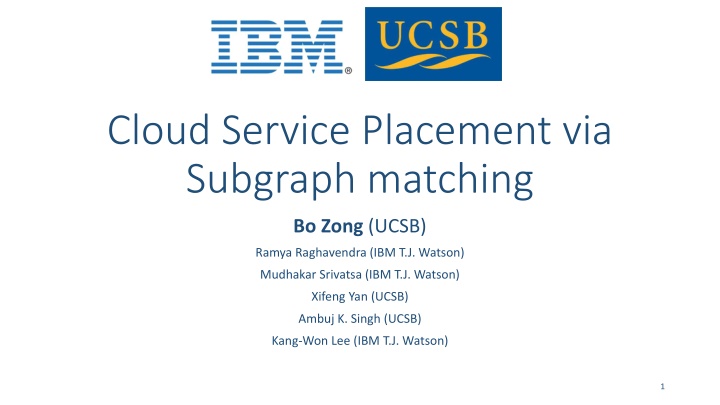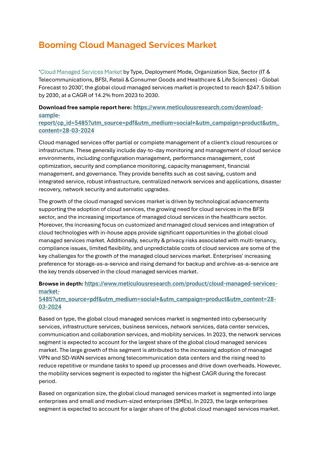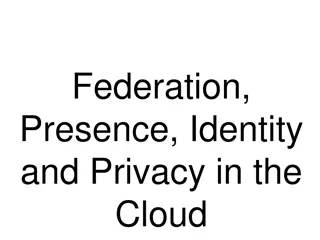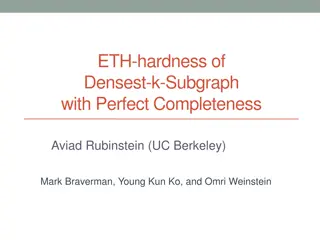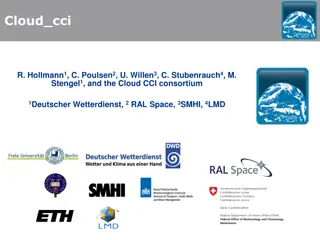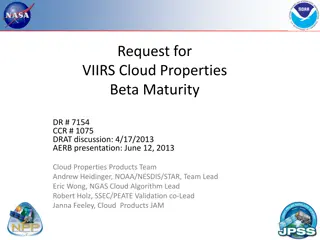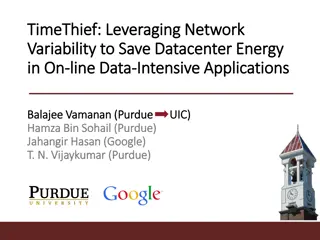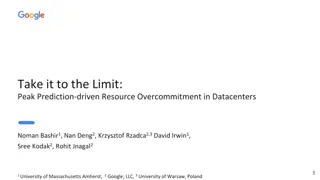Subgraph Matching for Cloud Service Placement in Datacenters
This research explores the efficient placement of cloud services in datacenters through subgraph matching, focusing on compatibility and resource optimization between customers and providers in cloud computing environments. The study highlights challenges in dynamic subgraph matching and the limitations of existing techniques in adapting to frequent label updates and scaling with large data/query graphs.
Download Presentation

Please find below an Image/Link to download the presentation.
The content on the website is provided AS IS for your information and personal use only. It may not be sold, licensed, or shared on other websites without obtaining consent from the author.If you encounter any issues during the download, it is possible that the publisher has removed the file from their server.
You are allowed to download the files provided on this website for personal or commercial use, subject to the condition that they are used lawfully. All files are the property of their respective owners.
The content on the website is provided AS IS for your information and personal use only. It may not be sold, licensed, or shared on other websites without obtaining consent from the author.
E N D
Presentation Transcript
Cloud Service Placement via Subgraph matching Bo Zong (UCSB) Ramya Raghavendra (IBM T.J. Watson) Mudhakar Srivatsa (IBM T.J. Watson) Xifeng Yan (UCSB) Ambuj K. Singh (UCSB) Kang-Won Lee (IBM T.J. Watson) 1
Cloud datacenters Datacenters shared by multiple customers Popular cloud datacenters Provider: Amazon EC2, Microsoft Azure, Rackspace, etc Customers: renting virtual machines for their services Profitable business In 2013, Microsoft Azure sold $1 billion services By 2015, Amazon web services worth ~$50 billion 2
Cloud service placement User-defined cloud service Node: functional component Edge: data communication Label: required resources Memory requirement cloud service v1 v2 v3 v4 v5 v6 v7 8G 4G 2G 2G 12G 32G 32G v3 v6 v5 v1 v2 1 Gbps 10 Mbps v4 v7 Placement Place the service into a cloud datacenter A set of servers hosting the service 3
Compatible placement Cloud abstraction Cloud abstraction Node: servers Edge: communication link Label: available resources Compatible placement requires Isomorphic substructure Sufficient resources Benefit both customers and providers Customer: expected performance Provider: higher throughput Cloud service v3 v6 v5 v1 v2 v4 v7 How to find compatible placement? 4
Outline Introduction Problem statement Gradin Graph index for frequent label updates Accelerate fragment join Experiment results 5
Dynamic subgraph matching 0.6 Input Data graph G (frequently updated numerical labels) Query graph Q Output: Q s compatible subgraphs from G Q v3 0.1 v1 v2 0.7 v4 0.3 0.9 0.9 0.1 S2 S3 S1 0.2 0.2 0.2 0.9 0.9 0.1 0.5 0.3 0.1 NOT compatible NOT compatible Compatible 6
Existing techniques for subgraph matching Graph indexing techniques Include exact, approximate, or probabilistic subgraph matching Cannot adapt to graphs of partially ordered numerical labels Cannot scale with frequent label updates Non-indexing techniques Cannot scale with the size of data/query graphs 7
Outline Introduction Problem statement Gradin Graph index for frequent label updates Accelerate fragment join Experiment results 8
Offline graph index construction Canonical labeling v1: 0.1 Decompose graph information Structure: canonical labeling Label: vectors 1 2 2 3 2 4 4 1 v2: 0.7 Label ID (0.6, 0.7, 0.1, 0.3) (v3, v2, v1, v4) v4: 0.3 v3: 0.6 Indexing graphs of numerical labels G Label vectors for fragments (subgraphs) labeling(s1) labeling(s2) labeling(s3) labeling(s4) labeling(s5) s1 s2 s3 s4 s5 9
Online query processing Large search space Cq1 q1 Cq2 q2 + Graph Index Q Output ... Cqk ... qk Compatible subgraphs Fragment join Query graph Query fragments Index filtering Compatible graph fragments Frequent label updates 10
Outline Introduction Problem statement Gradin Graph index for frequent label updates Accelerate fragment join Experiment results 11
Frequent label updates Where are the label updates from? Cloud services come and go Upgrade hardware in datacenters 30% of node labels are updated in a 3000-node data graph > 5M graph fragments will be updated State-of-the-art R-tree variant takes > 5 minutes Inverted index scans all fragments for searching FracFilter Fast fragment searching Fast index updating 12
FracFilter: construction Grid index for each indexed structure Label vectors for fragments (subgraphs) Index label vectors labeling(s1) labeling(s2) labeling(s3) labeling(s4) labeling(s5) Map fragments into grids Grid density : #partitions in each dimension Partition the space into grids 13
FracFilter: search Input: label vector of a query fragment Output: compatible graph fragments Procedure: Find the grid for query fragment Fragments in R1 are compatible Fragments in R3 are not compatible Verify fragments in R2 Parsimonious verification Reduce ~ 80% comparisons No quality loss 14
Tune searching performance by grid density Analytical result: we need ??? ?, grid density ?, the number of dimensions for structure s ??, the number of graph fragments Assumption 1: graph fragments are uniformly distributed Assumption 2: query fragment is uniformly distributed When ? increases, FracFilter is more efficient for searching The efficiency gain will diminish ??(?+1 2)? 1 comparisons in average 15
FracFilter: update Update FracFilter for a graph fragment Identify the old grid, and delete the fragment Find the new grid, and insert the fragment 1 Analytical result: 2(1 ?, grid density ?, number of dimensions Assumption: graph fragments are uniformly distributed When ? increases, FracFilter is less efficient for updating ??) operations per update in average 16
Outline Introduction Problem statement Gradin Graph index for frequent label updates Accelerate fragment join Experiment results 17
Large search space A small query graph can have many query fragments A 10-star query has 720 3-star query fragments Only need some of them to cover the query graph Which query fragments do we need? Minimum fragment cover 18
Minimum fragment cover Input Query fragment {?1,?2, ,??} for Q Matched graph fragments {?1,?2, ,??} Output: a subset ? {?1,?2, ,??} Fragments in F cover all edges of Q ? = ?? ?log(|??|)is minimized A greedy algorithm can approximate it within ?(log(? )) ? , #edges in a query graph 19
Large search space (cont.) Joining two query fragments could be daunting Both q1 and q2 have 1M matched graph fragments Joining q1 and q2 needs ~ 1012 comparisons How to make it faster? Fingerprint based pruning 20
Fingerprint based pruning Given a fragment join order, extract fragment fingerprints in linear time Minimum fragment cover Organize fragments by fingerprints qi Join order: q1 q2 q3 Fingerprint Ci Graph fragments f1 f2 fn (v2, v3, v5) (v3, v5, v4) (v1, v2) 21
Fingerprint based pruning (cont.) qi+1 q1 qi Fingerprint Ci+1 graph fragments g f f1 f2 fn Prune unnecessary search qi qi+1 Graph fragment g, a partial match from q1 qi Extract the fingerprint f which g is looking for Check the graph fragments in ??+1 of fingerprint f 22
Outline Introduction Problem statement Gradin Graph index for frequent label updates Accelerate fragment join Experiment results 23
Setup Data graph BCUBE: 3000 ~ 15000 nodes, average degree 18~20 CAIDA: 26475 nodes, 106762 edges Numerical labels and updates Label generator derived from ClusterData Query graph All possible graphs of no more than 10 edges Generate Labels from Uniform(0, 1) Baselines: VF2, UpdAll, UpdNo, NaiveGrid, and NaiveJoin 24
Query processing Return up to 100 compatible subgraphs in < 2 seconds Up to 10 times and 5 times faster than UpdNo and NaiveGrid Close to UpdAll 25
Index updating Process 9M updates in 2 seconds Up to 10 times faster than UpdAll 26
Scalability Gradin is up to 20 times faster than UpdAll on index update Gradin is 10 times and 8 times faster than UpdNo and NaiveGrid 27
Conclusion Cloud service placement via subgraph matching Gradin Indexing graphs of numerical labels Fast query processing Fast index updating Gradin outperforms the baseline algorithms on query processing and index updating. 28
Thank you 29
